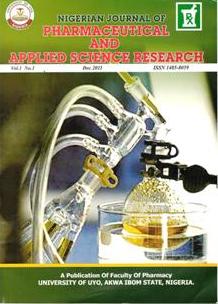An ethnobotanical survey of medicinal plants used in the management of breast cancer in Dambam Local Government, Bauchi State
Main Article Content
Abstract
Cancer is the abnormal growth of cells, typically originating from a single mutated cell. The cells have lost normal control mechanisms and thus can multiply continuously, invade nearby tissues, migrate to distant parts of the body, and promote the growth of new blood vessels from which the cells derive nutrients. Breast cancer is the most frequently diagnosed cancer and the leading cause of cancer death in men and women, respectively, both overall and in less developed countries, however, prostate cancer is the most frequently diagnosed cancer among women. To conduct and document the traditional knowledge and usage held by different communities regarding using medicinal plants for managing breast cancer. Materials and methods: semi-structured questionnaires were used to discover the practice of traditional medicine using plants, and the data collected was imputed into a statistical package for social science to analyze the results. Results: The results revealed that most respondents were married 89.2%, with a 60% age range between 30-50 years, and most of their tribes are Hausa/Fulani with 98%. The results revealed that 24 plants are used for managing breast cancer in the locality, with Taura, kriya, Ararrabi, Sabara, Janyaro, Majamfari, Danya, and Bindazugu are the most commonly used in the management of breast cancer, method of preservation was mostly shed drying with 58% and stored in the container, route of administration usually oral with 92% and 8% topical. Conclusion: An ethnobotanical survey of medicinal plants used in managing breast cancer was conducted in Damabm LGA using semi semi-structured questionnaire.
Downloads
Article Details

This work is licensed under a Creative Commons Attribution-NonCommercial-NoDerivatives 4.0 International License.
References
Ferlay, J., Shin, HR., Bray, F. (2010).Global burden of breast cancer. Breast Cancer Epidemiology, pp.1- 19
. Kingsley, C. (2010). Cultural and socioeconomic factors affecting cancer screening, early detection and care in Latino population. Retrieved 13 November 2019 from: https://ethnomed.org/clinical/cancer/cultural-andsociocconomic-factors-affecting-cancer-screening-carlydetection-and-care-in-the-latino-population
. Izanloo, A., Ghaffarzadehgan, K., Khoshroo, F., Erfani, M.H., Izanloo, S. (2018). Knowledge and attitude of women regarding breast cancer screening tests in Eastern Iran. Ecancermedicalscience, 12, 806.
. Berhaut, J. (2015). Flore illustree du Senegal dicotyledones: tome 1. Acanthaceesa Avicenniacees.Dakar:Ministere du Developpement Rural 626p.Illustrations Geog, 5.
. David, and Thomas, Md. (1984). Do Hormones Cause Breast Cancer?., ACS Journals.3(53):595-604.
. Obute and Osuji 2012. Current trends in ethnobotany. Trop J pharm Res.,8(4), 295-297
. Elmore, J.G., Amstrong, K. and Lehman, C.D. (2005). Screening for breast cancer JAMA, 293: 1243-6.
. Graham, Ac., Bernard, Ar. And Frank, Es. (1996) Risk Factors of Breast Cancer According to Family History of Breast Cancer., Journal of the National Cancer Institute 88(6):365-3716
. Lyon, France: 2020. [(accessed on 9 July 2021)]. Global Cancer Observatory: Cancer Tomorrow. Available online: https://gco.iarc.fr/tomorrow [Google Scholar]
. National Cancer Institute (NCI) (2021). What is Cancer, Available at. https://www.cancer.gov/about-cancer/understanding/what-is-cancer
. Cragg, G. M. (2007). Plants as a source of anti-cancer agents. Journal of Ethnopharmacology, 100(1), 72-79
. Rahman N., The Breast Cancer Susceptibility Collaboration (UK) Seal S., Thompson D., Kelly P., Renwick A., Elliott A., Reid S., Spanova K., Barfoot R., et al. PALB2, which encodes a BRCA2-interacting protein, is a breast cancer susceptibility gene. Nat. Genet. 2006;39:165–167. doi: 10.1038/ng1959.
Chukwuneke F, et al. Culture and biomedical care in Africa: the influence of culture on biomedical care in a traditional African society, Nigeria, West Africa. Niger J Med. 2016;21 (3):331-3
. Carey K. Anders, Rebecca Johnson, Jennifer Litton, Marianne Phillips, and Archie Bleyer®, Breast Cancer Before Age 40 Years Semin Oncol. 2009 June ; 36(3): 237–249. doi: 10.1053/j.seminoncol.2009.03.001
. Ebadi, M. T., M. Azizi, F. Sefidkon, and N. Ahmadi. 2015. Influence of different drying methods on drying period, essential oil content, and composition of Lippia citriodora Kunth. Journal of Applied Research on Medicinal and Aromatic Plants 2 (4):182–7. doi: 10.1016/j.jarmap.2015.06.001
Sharma, A., C. R. Chen, and N. V. Lan. 2009. Solar-energy drying systems: A review. Renewable and Sustainable Energy Reviews 13 (6-7):
-210. doi: 10.1016/j.rser.2008.08.015.
. Pirbalouti, A. G., E. Mahdad, and L. Craker. 2013. Effects of drying methods on qualitative and quantitative properties of essential oil of two basil landraces. Food Chemistry 141 (3):2440-9, doi: 10.1016/j. foodchem.2013.05.098.
. Khorshidi, J.. R. Mohammadi, T. Fakhr, and H. Nourbakhsh. 2009. Influence of drying methods, extraction time, and organ type on the essential oil content of rosemary (Rosmarinus officinalis I.). Natural Science 7 (11):42-4.
. Busia K. Fundamentals of Herbal Medicine. 1 & 2. Milton Keynes, UK: Lightning Source UK Ltd.; 2016. [Google Scholar]
. Gurib-Fakim A. Medicinal plants: traditions of yesterday and drugs of tomorrow. Molecular Aspects of Medicine. 2006;27(1):253–255. doi: 10.1016/j.mam.2005.07.008. [DOI] [PubMed] [Google Scholar]
. Van Andel T., van Onselen S., Myren B., Towns A., Quiroz D. The medicine from behind: The frequent use of enemas in Western African traditional medicine. Journal of Ethnopharmacology. 2015;174:637–643. doi: 10.1016/j.jep.2015.06.040. [DOI] [PubMed] [Google Scholar]


